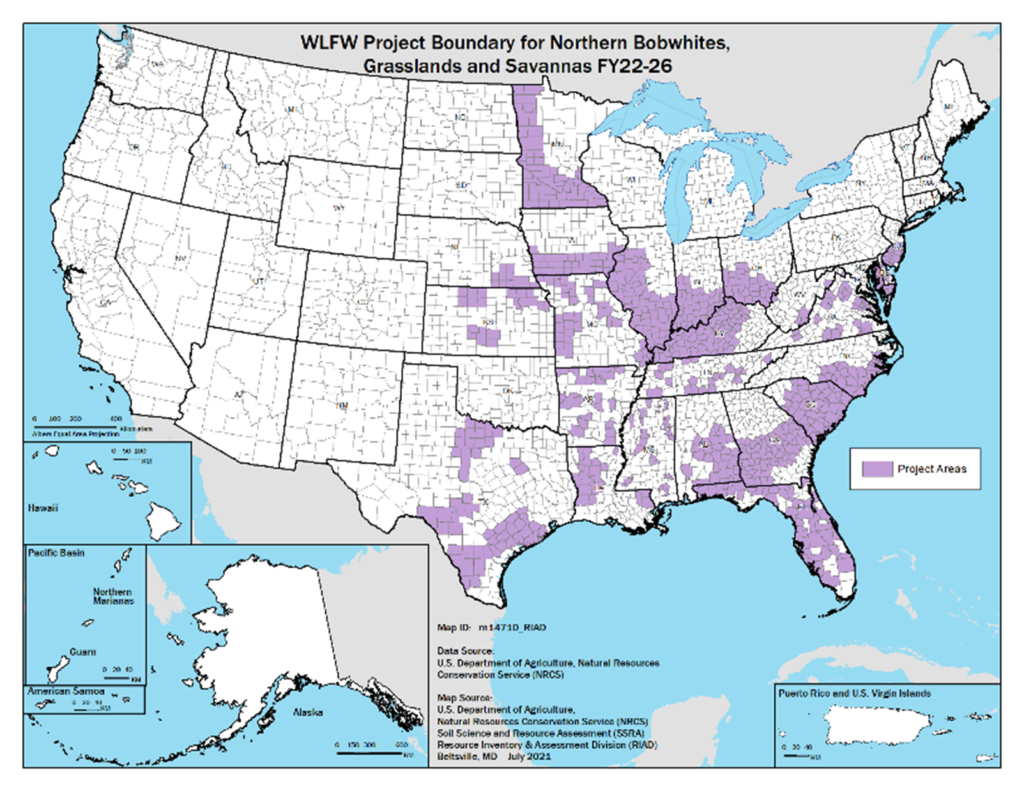One Farm Bill conservation program aims to conserve 7 million acres of quail habitat by 2026
For farmers, ranchers, independent foresters, and other private landowners, conservation is a constant balancing act between pursuing ecological benefits and ensuring economic sustainability. Agricultural producers operate in a sea of market variables that put pressure on their operations, and successful efforts to conserve lands and waters can, in fact, complement growing operations.
This is exactly the aim of the Working Lands for Wildlife Program.
Since 2012, this Farm Bill program has empowered the voluntary conservation of priority habitat through the improvement of working landscapes, providing a win-win for wildlife and landowners. In partnership with state agencies, conservation groups, and landowners, the Natural Resources Conservation Service identifies priority species for conservation through WLFW, and so it has become an important tool in averting the need for costly endangered species protections. Click here for a map outlining existing WLFW species initiatives in 2021.
The iconic bobwhite quail has been a target species of the WLFW program since 2017. Bobwhites are considered an “edge” bird and can be found along crop fields, as they demand a variety of grassy cover and forbs to provide food, shelter, and protection. But bobwhite populations have fallen by over 80 percent in the last three decades because of habitat conversion, fragmentation, and degradation.
Fortunately, the WLFW Bobwhite Initiative has facilitated motivated state conservationists and partner groups—like Quail Forever and the National Bobwhite Conservation Initiative—as well as landowners, to leverage federal funds and technical assistance available through WLFW to the species’ advantage.
The WLFW Bobwhite Quail Initiative is currently underway in 24 states, and was recently expanded through the renewed 2022 WLFW Bobwhite, Grasslands, and Savannas Framework for Conservation Action—which sets program goals for the next five years.
 The 2022 framework sets an ambitious course for the future of grassland and quail habitat conservation in the central and eastern U.S.: Through Fiscal Year 2026, the NRCS intends to conserve 7 million acres of bobwhite habitat through the WLFW initiative.
The 2022 framework sets an ambitious course for the future of grassland and quail habitat conservation in the central and eastern U.S.: Through Fiscal Year 2026, the NRCS intends to conserve 7 million acres of bobwhite habitat through the WLFW initiative.
With technical assistance from the NRCS, state and NGO partners will prioritize areas where there is the greatest need and practices that will make the biggest impact, such as the removal and monitoring of invasive trees across native grass ranges in Kansas. In states like Georgia and South Carolina, brush management and timber thinning will restore the health of forest stands and return undergrowth for brooding, nesting, and winter habitat. Several other states will seek easement agreements with landowners to secure habitat that is under threat.
Recovering bobwhite quail populations will take many years and require the thoughtful, collaborative model of conservation showcased by the Working Lands for Wildlife Program. Fortunately, conservation practices have wide-reaching impacts, from reducing input costs and increasing yields for producers to sequestering carbon and improving water quality. Enhanced habitat and connectivity for bobwhite quail will also benefit songbirds, pollinators, and countless other species—creating an ecosystem-wide impact that multiplies conservation value.
The thoughtful implementation of the WLFW program, as well as others in the Farm Bill’s conservation title, provides locally led efforts with the financial and technical support to reverse decades of habitat loss. We’re eager to see that work continue. Click here to learn more about our goals for the next Farm Bill.



























